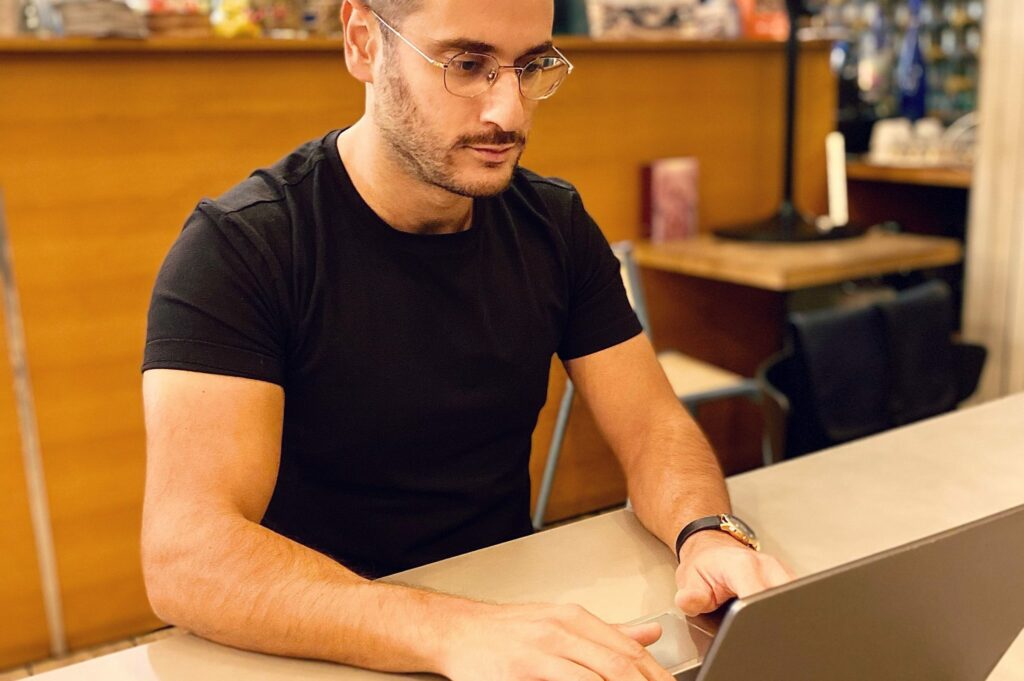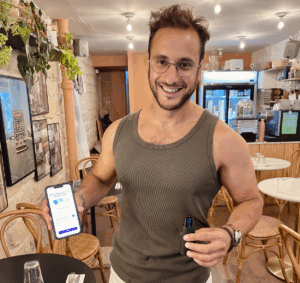Hello everyone!
I am taking advantage of this second confinement to write a little note of help to all my fellow restaurateurs on the best way to launch its own click&collect service (so take it with you), and its internal delivery service, in addition to Deliveroo, UberEATS and others. And moreover, I offer you a little thought to find out if, in the end, own delivery is really profitable, or not.
I had already done a post on delivery by business providers Deliveroo and UberEATS, and here, I will remain mainly focused on everything that is internalized. As you can see, launching your own system is not an easy task and above all, it is not necessarily a panacea in terms of profitability!
First of all, before starting, we must distinguish two things to help you read this article and move forward in your thinking:
- There is the TAKE AWAY, which we will also call here the CLICK&COLLECT. This involves placing an order and picking up your order (ideal for lunch outside the office, bakeries, or even meals on request or any other non-food retail business).
- There is DELIVERY, which can be added to the Click&Collect service, and which will also involve a whole logistical part (customer address, deadlines, delivery costs, and connection with other delivery services, I will come back to this).
Delivery and click&collect are not essential for everyone, which is why we had to make the distinction. The choice of the tool you are going to use will be made on this basis: a baker will, for example, not necessarily want to deliver, and will not take an expensive and heavy tool but something simpler.
Part 1 – The best click&collect services for restaurants, bakeries, and other retail businesses
Before seeing together the relevance of this model, I will take a quick overview of existing click&collect services, then I will explain to you what methodology to adopt. This already allows me to have a summary of what exists, which will help me in my thinking, and since I'm thinking about that, I might as well share it with all the restaurants.
Here is a non-exhaustive list of click&collect solutions. If you have others to suggest, don't hesitate to suggest them in the comments and I will add them!
The quickest to deploy: that of your cash register software
Normally, POS solutions like Zelty Or Innovorder for example, offers a very simple click&collect solution to be deployed quickly, and directly connected to your cash register, which is an extremely important variable for being able to launch your click&collect system (we will see this in the method).

So, already check your checkout solution to see if there is a click&collect solution. In addition, it may be offered at a low price or free of charge during periods of confinement, to help restaurateurs (this is what Zelty does, see below).
- Advantages: connected to the box, easy to set up, and speed of deployment.
- Disadvantages: this is not the primary purpose of cash register software, so the solution will perhaps be limited in terms of functionality and user experience, and will only be available on the web and mobile web (no native app ).
The case of Zelty, all-terrain cash register software
Zelty is one of the most popular POS in France. And for good reason, it is one of the most complete, and the team at 100% is focused on constantly improving their tool. As such, Zelty was among the first to offer Click&Collect in France, starting in 2015.
Then, Zelty also offers everything related to delivery management, with online ordering provided of course – the same as click&collect but with the delivery option – and all integrated directly into Stuart, the on-demand delivery service provider, this which is super practical.
Finally, that's good, Zelty offers its Click&Collect tool free of charge to all its customers, but also to restaurateurs who do not use the Zelty cash register! And this since mid-March and until the end of the year at least. No order limit (unlike others), and no commitment. It is therefore possible to use Zelty Click&Collect, without having to change cash register software. Practical for testing the market!
Flipdish: the most modern
Flipdish is the platform that seemed the most attractive to me! Having tested both as a restaurant and as a consumer customer of their restaurant customers, everything is there: take-out, delivery, super simple dashboard, no bugs, etc…
In addition, they even offer the creation of your own native app, in your colors, for not very high prices!
On the other hand, the prices are based on a commission and not a fixed one, which, for a restaurant that has to have volume, risks adding significant costs in terms of profitability...
- The advantages: 360 offer (native app, website, mobile web, dashboards, etc.)
- Cons: commission-based pricing.
Siouplaît: the most attractive
Siouplaît is, like Flipdish, one of the most modern platforms available on the market in my opinion. And for good reason, their solution integrates both click&collect and delivery, where most of the players are completely absent from the delivery part, which is, it must be admitted, a very complex activity to manage internally. And at Siouplaît, the delivery part seems very successful.
Indeed, Siouplaît provides a range of very fine options, such as pre-ordering, configuring delivery zones, delivery costs per defined zone, order minimums per zone, delivery costs offered based on a certain amount reached, and even a possibility of assigning orders received to delivery people, if you have an in-house fleet.
And for restaurateurs or other merchants of all kinds who used the Stuart solution (outsourced couriers), Siouplaît is connected to Stuart!
And in addition to being connected to Stuart, Siouplaît is also connected to Rushour, the order centralization solution, which allows you to have on a single tablet, all of the orders coming from UberEATS, Deliveroo, and therefore also your internal orders via Siouplaît! Super practical.
Price-wise, it starts at €75/month, without commission, which is a great offer. All that's missing is a dedicated app, even if it means paying a large development cost and a flat rate for putting it online on the app store and the play store, and Siouplaît will be completely complete. To be tested as a priority!
Pulp: an outsourced click&collect solution
With Pulp, you can create your menu online, but it will be available on a platform, such as Deliveroo or UberEATS, but it will not be your own ecosystem.
On the other hand, if the service becomes known, you will have more volumes, since you will not be alone in your area, integrated into a catalog of several restaurants!
Speedle: same philosophy as Pulp
Here too, if I understand correctly, it’s a “Deliveroo takeaway”, to put it simply. It's not about internalizing your takeaway customers, but using a takeaway platform with other restaurants. To try.
Click-Eat, one of the pioneers
Click-Eat were one of the first to offer this click&collect service. If the first results were in its infancy at the time, the tool is now much more advanced, and a lot of restaurants have adopted their solution.
In addition, Click-Eat also offers delivery for restaurants that wish it: you create your own delivery zones, specifying your prices (delivery costs) and your delivery people. The orders fall into a dashboard, and you manage your menu online from your administrator account.
In addition, the main advantage of using click-eat is on the financial level. They had the good idea of offering a non-binding offer which is commissioned, and which therefore allows you to use the tool to test it, and if it is promising, you can go for a one-year offer, fixed, at €59, and not commissioned, which is absolutely profitable if you have a certain volume, since you will easily amortize these €59.
I haven't tested this solution, but it looks very promising!
Wysifood
Wysifood is one of the interesting players to follow in this field, since they offer both takeaway and delivery, and their site offers a fairly convincing and very aesthetic online demo.
Providing demos quickly is a great sales argument for knowing where you are going without spending too much time. You can configure your delivery zones, obviously offer click&collect, but also offer an on-site table reservation service, and according to their site, synchronize orders with your cash register software (but they do not specify which POS they are integrated into). ?).
However, no idea of the prices.
ZenChef, the history of table reservations
Originally, ZenChef is known for its very practical table reservation tool, which allowed restaurateurs to internalize their reservations, by offering a module for reserving a table on their own website.
It was a very practical tool for “classic” restaurants that are not suited to delivery or click&collect, and it had the advantage of “freeing up” or in other words, not being dependent on 100% from La Fourchette, which charges €2/customer, which is relatively unfair for restaurants with low average baskets.
Parenthesis. Indeed, in an entrepreneurial strategy, you must always test alternative solutions in order to try as much as possible not to put your eggs in the same basket. Digital entrepreneurs who made their money solely with Google SEO sometimes learned this the hard way when social networks arrived, but also hoteliers with Booking, etc.
From, ZenChef launched its Click&Collect service, without delivery service it seems to me, and during confinement, the solution is free.
I imagine that it is a very simple solution, only web and mobile web, and with a notification sent to the customer when the order is accepted and/or it is ready via SMS and/or email, which is already not bad for most small business owners.
I haven't tested it, I don't know what it's worth, but worth testing!
TastyCloud: historically ordering on tablet
Here again, we are in a “pivot” of a player whose core business is, just like its competitor Tabesto, to provide McDonald's ordering tablets but prettier, more mobile, and above all less expensive.
But since then, TastyCloud now offers its customers a Click&Collect solution integrated into your website for free. Obviously without a native app, it's not their job at the moment, but it's already great. Furthermore, TastyCloud also offers the famous reminder notebook, the menu via QR Code, and everything is connected to your cash register, namely the most famous: Zelty, Popina, Tiller, iKentoo, etc…
To test !
GloriaFood: tested and (almost) approved
I tested GloriaFood extensively because in theory it is the ultimate tool for all small and medium sized restaurants. They offer takeaway, delivery, table reservation, native applications, a free offer to try, all at unbeatable prices.
In addition, creating your click&collect and delivery system is ultra-simple, you don't have to discuss with a salesperson, there is nothing nebulous, it's really plug&play.
The problem, and it's a big one, is the rather archaic user experience, with in particular an eliminatory variable in my opinion which is the part where the customer enters their delivery address. Indeed, Gloriafood does not use auto-completion, so it is super strange when the customer enters their address, because they then have to move a pin on a map to confirm their address, which results in a change of address .
I had already informed them of this problem, but they did not want to integrate auto-completion, which, in 2021, is prohibitive... It's a shame, because on paper, it was the best solution to get started in click&collect and especially delivery!
Part 2 – What methodology for choosing and launching your own click&collect service?
Several variables come into play, depending on your issues. If you don't know much about it, here is how I think you should think about starting your digitalization without going anywhere, with a service or a start-up that would not be suited to your profile.
Question 1: Takeout or delivery?
The first question you need to answer is whether if your business just needs to launch its take-out service, or kill two birds with one stone with a delivery service.
If for example you are a bakery, unless you are a famous pastry shop whose customers would like to order galettes des rois online for the epiphany, if the majority of your turnover consists of selling croissants and sandwich or salad menus at lunchtime, it is better to turn to a “click&collect” solution only and no delivery, because the delivery issues (logistics, costs, etc.) will be far too heavy to bear and not really suitable.

If, on the other hand, you are a pizza brand with a strong identity and an extremely loyal customer base, then you have everything to gain from betting on a combined click&collect and delivery solution.
Question 2: native app or web and mobile web?
Once you have chosen your distribution channel, you need to choose the medium on which you will “speak” to your customers. And here again, I suggest you reason with concrete examples:
- If you are a salad bar or an independent food truck and you are a hit at lunchtime at the bottom of an area with a high density of offices, the question of a dedicated app, heavy in terms of development, and that your customers do not will use “that” when used in your catchment area, hardly arises. You might as well give them your website first, so they can order from their office on their computer.
- If you are a medium or large brand with several brands in the same city, or even in a country or in several countries: bet everything on a native app! It will be used by your loyal customers regardless of their location.
Question 3: what integrations?
Let's imagine that you are now stuck on the distribution channel, as well as the media. When you compare the different providers who “match” with these two variables, one of the most important things is to look at how you are going to process orders, both practically and from an accounting perspective!
Indeed, if the orders fall into an email box, which is not consulted, and in addition there is delivery to manage, you then have to copy and paste the delivery information for your delivery provider, or send them manually to your delivery person: it's the gas factory. You will deliver poorly, and your customers will not recommend. Not to mention retyping the orders manually at the end of the day in the cash register.
You must therefore choose a service provider:
- Which is integrated into your cash register software (even if it means changing it)
- Which is possibly connected to a delivery platform aggregator. For example, Flipdish, a click&collect tool, is integrated with Otter, an aggregator which syndicates UberEATS, Deliveroo and therefore Flipdish orders, and which therefore allows you to have everything in the same place, and to print tickets in the kitchen automatically. Practical, therefore: it doesn't solve the integration with the POS, but at least in terms of kitchen preparation, we are on top since everyone knows that an order has arrived and that it must be prepared.
- If no platform aggregator, a service which possibly provides a restaurant APPLICATION: that is to say a tablet which, like Deliveroo and UberEATS, rings and alerts you when a new internal order comes in. Once validated, ideally it goes into the cash register software for printing, if not at least connected to a Bluetooth printer. This application can also allow the assignment to your delivery people if you have a fleet.
- A service that is integrated into on-demand courier platforms (Stuart and ZitiCity for example). Some aggregators also do it, as do certain cash register software (like Zelty connected to Stuart).
- A service which will inform the end customer about the progress of their order: if native app via push, if web via SMS or email, etc…
- Etc…
The integrations are extremely important because they will guarantee a very well-oiled system, which will allow you to receive orders, process them, count them at the cash register, send them to the delivery person, etc. This will avoid “zapping” orders, or treat them badly, etc.
Example of methodology
I'm just giving an example to clearly illustrate this whole mess. So, you can write a logical and sequential diagram this way, replacing the solutions proposed here with your own choices and problems:
- The brand decides to go with a web solution, mobile web + native app
- The customer places an order online, and will receive notifications by email or SMS. If he downloads the app, he will receive push notifications (more economical, notably via the One Signal tool, sometimes integrated into certain services). He will even benefit from a promotional code for his first order!
- Depending on its delivery area, it is this or that restaurant that receives the order on a ringing tablet (very important). The restaurant validates, the customer receives a notification, and the restaurant prepares.
- Once the order is ready, the restaurant just has to click a button to call a Stuart courier, who comes to collect the order and who already has all the information on its Stuart app.
- The end customer is notified by push that the order has left the restaurant once the restaurant “sales” the order.
- If the restaurant uses an internal fleet, some service providers even offer the delivery part, where basically the customer sees the assigned delivery person, and can follow him on the map, etc. Here, we are in the “cloning” of UberEATS and Deliveroo, but it is very expensive.
Once you have summarized your ideal route, you can choose your services. Sometimes, it will be necessary to give up on certain services, which are too expensive or, for example, not provided by this or that service. And above all, don’t do something too advanced, expensive and complicated from the start if you are a small or medium-sized brand…
Part 3 – The profitability of internalizing your orders
Wanting to internalize your orders, and especially your deliveries, rather than going entirely through third parties, is it profitable? And if not, should we do it anyway? Here are some thoughts, for what they are worth…
Concerning personal delivery
When you start delivering, as I already explained in a previous post, the problem will be profitability (in addition to commercial success). You can have a lot of orders, but if the customer doesn't pay the "real" price, you may also be digging your grave.
 Indeed, unless you make pizza for example, if your goods rate and your labor rate are high, your food is not made for delivery, unless the end customer is willing to pay the price .
Indeed, unless you make pizza for example, if your goods rate and your labor rate are high, your food is not made for delivery, unless the end customer is willing to pay the price .
However, we are witnessing a very cruel paradigm in the world of food delivery, is that the customer's perceived value is often well below the real value. As a result, the customer is not ready to pay the real price that the product costs with the delivery commission, and the restaurateurs, to compensate for the lack of volume, and in search of commercial success, shoot each other with red balls in waging a price war.
So, to avoid falling into this trap, and even if it means having less volume, when you launch your menu for delivery, the most important thing is first to set a price that is consistent with your material cost, and the cost it was necessary to spend money to transform the product (machines, labor, etc.), and therefore ensure a margin. In addition, with the Uberized system, and therefore a fixed commission often of 30% per order, it is easier to calculate a net commission margin, where at the time, profitability depended on the number of orders that a permanent pizza deliveryman would take in his top box. In the old model, the fluctuating charge relating to sales volume was mainly the cost of internal delivery people. In the new model, the fluctuating load is only the costs of staff dedicated to the kitchen and preparing orders, this will be in higher or lower proportion depending on your turnover. Moreover, this could potentially rise (instead of decreasing) at a given moment when you will be obliged to work more in the face of an increase in sales, you will be in a fairly restrictive in-between, a bit like how tax brackets work.
Internally, unlike orders placed via business providers and which impose a fixed commission, the calculation is a little different, because we are in a hybrid system in terms of charges. Here are the different costs that you will need to plan for.
If you use an on-demand courier system, let's say Stuart for example (I don't recommend it but hey...), you will have to assume:
- €7.20 minimum for a small restaurant that has not negotiated large volumes (No VAT with Stuart because they are self-employed it seems to me).
- The credit card fees of a banking intermediary like Stripe, which generally amount to 1.4% + €0.25, or around €0.53 for an average basket of around €20 (I'm guessing!).
- Which is around €7.73, sometimes €8, and sometimes even much more if your order is located further away, because the cost of the Stuart increases.
If the total costs amount to €8, that gives approximately a “theoretical commission” of €8 / €20 = 40%. Insourcing therefore costs you more than going through business providers. And what's more, can be added to this:
- A commission of a few percent from your service provider (see Flipdish for example)
- Or a fixed subscription, which if it is high (let's say 100 or 180€ / month for certain very successful services), imposes a certain volume of orders on you to amortize it.
Concerning winning
A priori, click&collect solutions are inexpensive and easy to deploy. We can therefore put them in place without taking too many risks. On the other hand, consumer use is currently marginal.
In addition, customer loyalty and retention on these types of platforms are close to zero, because they do not have a real eco-system, allowing the customer to be kept in a universe and a practical native application. These are often web and mobile web pages, which for the moment are quite limited on a technical and functional level, and from which sending pushes, recording banking information, etc. are hardly possible.
On the other hand, with the democratization of PWA, a new, more universal application format for smartphones, things may be possible, but Apple still needs to agree to integrate this format into its Store, which is not the case today, unlike Google and Android on the Play Store.
Conclusion: what to do?
Let's start with ultra-optimistic hypotheses so that you understand my logic. If you have (or think you will eventually have) some of the following variables:
- A high average basket (quality products and/or very good perceived value of your products and your brand)
- A large volume (popular and/or publicized products)
- Close customers (cheaper delivery, whatever the solution adopted, external or internal couriers, it is often best to make a mix to manage peaks of activity)
- An internal ordering solution that does not charge you on each order
- Customers ready to pay significant delivery costs, because they are so addicted to your products (see McDo and their internal app, which goes through Stuart for delivery)
So there you are, the king of delivery and click&collect, and your online business should be roughly profitable, at least break even.
Now, if you do not meet all these conditions, what choice should you make? It all depends on the solidity of your structure, what your brand sells, your beliefs about the future of your products and the market, and the bet you want to make. Here too, I will reason by example:
- If you think that your products have strong delivery potential (innovative and addictive product, few competitors, strong graphic and visual identity, etc.)
- If you think you have a propensity to develop horizontally with several premises
- If you think that the delivery market or at least online ordering for takeout will explode where you are located (in France, delivery is still struggling compared to other countries)
- If you think your product keeps well during a trip
- If you bet that your brand will become strong enough for your loyal customers to download your own app
- Etc…
So yes, a financial and human investment to deploy an own delivery and click&collect solution, even if initially it is not profitable, is worth a try.
Conversely :
- If you market “standard” products (even quality ones, that’s not incompatible) with few barriers to entry.
- A low average basket
- A single brand with no intention of developing further
- A very utilitarian and practical offer based on volume for a short time
- Etc…
It is perhaps more prudent, initially, to turn to simple, quickly deployable, inexpensive solutions, like some that I mentioned at the beginning of this article, in order to go smoothly, not to not waste too much time and money on something that will not generate cash flow, and to test the waters and see if there is a demand for click&collect (except for covid, nothing is less certain…).

There you go, this is a post which is the fruit of my current reflections, oh so topical with the digitalization of catering and especially the covid-19 crisis. And to those who continue to play the sole card of business providers, or even dark kitchens (I have nothing against it, but in the context of diversification), I just say “be careful”, in the meaning that with this system, there are now few barriers to entry, a devastating price war and a dangerous dependence on third parties. Finally, we will perhaps get back to basics in a while, a bit like what happened on the Internet over the last five years: after being heckled, the big guys ended up eating the little ones.
Don't hesitate to bounce back and give me your opinion in the comments, I would be curious to discuss with you about the transformation and digitalization of retail, and the different survival and development strategies to adopt depending on the core business!
Finally, if you have other click&collect and delivery solutions to offer that I have not listed, do not hesitate to share them so that I can add them to the article!!
Thank you and good luck to all the restaurateurs 🙂






3 Responses
Billee
integrated with a lot of cash register and offers in addition to C&C, payment at the table, ordering at the table and the electronic meal beeper (not bad for preparing for the reopening)
http://www.billee.fr
Hello,
Nice article Ziyad. 🙂
However, I would like to correct the following:
Clickeat, Pulp (partoo food), flipdish or other order interfaces do not “deliver” themselves.
“Delivery” orders are rebalanced to STUART (LA POSTE group).
STUART has long been the only alternative. Today other players are emerging like “HOP”
Yours sincerely
Thank you for the clarification, it's obvious to me but it's true that it's not necessarily obvious to everyone, and I didn't know HOP, thank you for sharing!